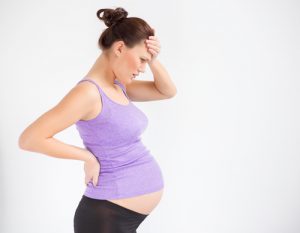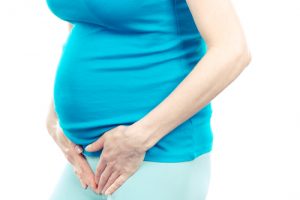Back (and other) Pain During Pregnancy – Osteopathy Can Help
 There is no greater example of how the body can adapt and change than throughout pregnancy. During pregnancy the mum-to-be has to adapt to major physical changes in a relatively short space of time, these changes, hormonal and structural, are all intended to help support the needs of the growing foetus. Sometimes these changes can result in some pain as the body tries to adapt, this is extremely common with 50-82% of women report some low back pain during pregnancy (1). It is important to remember that these changes are not a sign of something being wrong. Osteopaths have an in-depth knowledge of the postural and biomechanical changes that happen during pregnancy and can either manage or prevent the various aches and pains that occur (2).
There is no greater example of how the body can adapt and change than throughout pregnancy. During pregnancy the mum-to-be has to adapt to major physical changes in a relatively short space of time, these changes, hormonal and structural, are all intended to help support the needs of the growing foetus. Sometimes these changes can result in some pain as the body tries to adapt, this is extremely common with 50-82% of women report some low back pain during pregnancy (1). It is important to remember that these changes are not a sign of something being wrong. Osteopaths have an in-depth knowledge of the postural and biomechanical changes that happen during pregnancy and can either manage or prevent the various aches and pains that occur (2).
What happens to the mother’s body during pregnancy?
The answer here is ‘lots’, however the main changes that can cause aches and pain are hormonal and biomechanical (2).
Early in pregnancy the body secretes a hormone called relaxin to allow the ligaments of the spine and pelvis to ‘soften’ and allow the foetus space to grow. Tension in ligaments is crucial for the stability of the body’s biomechanics this can sometimes result in some muscle or joint pain.
During the pregnancy the weight gained, and how that weight is carried, will produce strain and load on the joints, muscles, ligaments and other structures of the body (3). The changes that occur most commonly result in back, neck, rib, and pelvic pain, however they can also be produce aches and strains in the wrists, knees, hips and feet (4, 5).

The changes that are most impactful are how weight of the mother’s body is distributed from front to back (4). As the foetus grows in the front of the body compensations happen so we can keep our balance, this can result in the spine having to change its natural curvature. Normally the spine is a shallow ‘s’ shape, pregnancy can lead to the spine increasing its curves. This change in shape and alignment can place extra stretch on the diaphragm, the muscles of the abdomen and mid back, as well as compressing the joints in the low back and neck. Sometimes the changes to the low back can result in the joints or discs placing pressure on the sciatic nerve which may refer pain down the leg as far as the foot. A similar problem can occur in the neck and shoulders meaning the nerves into the arms and hands are affected resulting in pain or numbness down the arms (4).
The pelvis is also an area that undergoes structural changes during pregnancy, this means more strain is placed on the pelvic structures such as the sacroiliac joints and the pubic symphysis. Some mothers happen to carry a lot of the weight of the foetus above the pubic symphysis resulting in symphysis pubis disorder (3). This is a very common feature of third trimester pregnancy which can be mild pain felt low in the pelvis, or severe pain that leads to problems walking or standing.
How Can Osteopathy Help?
Osteopathy is a safe and effective therapy that can help with the aches and pains that can accompany pregnancy. Osteopathy has a long history of working with expectant mothers, using various techniques to help them have a more comfortable time while pregnant.
There is evidence that shows that osteopathic treatment can help with low back pain during the later stages of pregnancy, and may contribute to improved outcomes in labour and delivery (5). The current National Institute of Clinical Excellence Guidelines for antenatal care also recommend techniques provided by osteopaths, such as massage and exercise, to help with painful symptoms during pregnancy (6). Even if you are planning to get pregnant osteopaths can provide hip and abdominal strengthening exercises to try to avoid the more common aches and pains that occur in pregnancy (4).
During the first 10 weeks of pregnancy low back pain is most commonly caused by hormonal changes, further hormonal changes occurring at weeks 4, 6, 12 and 16 mean it is advised not to have treatment at these weeks and ideally to wait until after you have had your 20 week scan. You do not need permission from your mid wife to receive osteopathic treatment but we advise you to keep them informed of any treatment you have with us and we are happy to liaise with them if necessary.
 At Align Body Clinic our osteopath and expert in pregnancy related pain, Sheena Harper, can provide assistance in various ways;
At Align Body Clinic our osteopath and expert in pregnancy related pain, Sheena Harper, can provide assistance in various ways;
• Undertaking a thorough case history and examination to produce an accurate diagnosis of your symptoms.
• Using gentle techniques such as massage and joint articulation to help the body absorb the changes necessary for the mother and baby to grow comfortably.
• Personally prescribed exercises for you to do at home to help keep you mobile and comfortable throughout your pregnancy.
Sheena’s experience and expert knowledge, coupled with her friendly nature and thorough approach to her job has resulted in her helping many mothers to be have a more comfortable and enjoyable pregnancy.
References
1 – Bullock J, Jull G, Bullock M (1987). The relationship of low back pain to the postural changes of pregnancy. Australian Journal of Physiotherapy. 33:11817.
2 – Stone C, (2007). Visceral and Obstetric Osteopathy. Elselvier, Philadelphia.
3 – Sandler S, (2012). Osteopathy and Obstetrics. Anshan, Tunbridge Wells.
4 – Souza, T. (2009). Differential Diagnosis and Management for the Chiropractor. 4th ed, Jones and Bartlett, Sudbury.
5 – National Council for Osteopathic Research (2012). Osteopathic management of patients during pregnancy. Online at; https://www.ncor.org.uk/wp-content/uploads/2012/12/Osteopathy-and-Pregna…
6 – National Institute for Clinical Excellence (2017). Antenatal care for uncomplicated pregnancies. Online at; https://www.nice.org.uk/guidance/cg62.
